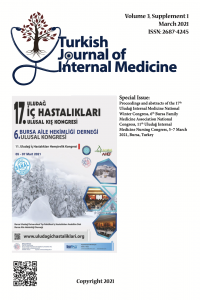Case Report
Year 2021,
Volume: 3 Issue: Supplement 1, 85 - 86, 07.03.2021
Abstract
Diabetic ketoacidosis (DKA) is a leading cause of mortality and morbidity in type 2 diabetic patients. Sodium-glucose co-transporter (SGLT-2) inhibitors are a new antidiabetic treatment class that increases the renal excretion of glucose. The Food and Drug Administration issued a warning in May 2015 notifying that patients using this class of anti-diabetic drugs may develop DKA. Risk factors for DKA development among patients who take SGLT-2 inhibitors include carbohydrate intake/starvation or acute illness. In the current report, we aimed to present a case of euglycemic DKA using dapagliflozin treatment.
References
- 1. Chao EC, Henry RR. SGLT2 inhibition--a novel strategy for diabetes treatment. Nat Rev Drug Discov 2010;9(7):551–9.
- 2. Dhatariya KK, Umpierrez GE. Guidelines for management of diabetic ketoacidosis: time to revise? Lancet Diabetes Endocrinol 2017;5(5):321–3.
- 3. Yu X, Zhang S, Zhang L. Newer Perspectives of Mechanisms for Euglycemic Diabetic Ketoacidosis. Int J Endocrinol 2018;2018:7074868.
- 4. Fralick M, Schneeweiss S, Patorno E. Risk of Diabetic Ketoacidosis after Initiation of an SGLT2 Inhibitor. N Engl J Med 2017;376(23):2300–2.
- 5. Food and Drug Administration, FDA drug safety communication: FDA warns that SGLT2 inhibitors for diabetes may result in a serious condition of too much acid in the bloodNovember 2019 http://www.fda.gov/Drugs/Drug.Safety/ucm446845.htm.
- 6. Taylor SI, Blau JE, Rother KI. SGLT2 Inhibitors May Predispose to Ketoacidosis. J Clin Endocrinol Metab 2015;100(8):2849–52.
- 7. American Diabetes Association. 9. Pharmacologic Approaches to Glycemic Treatment: Standards of Medical Care in Diabetes-2021. Diabetes Care 2021;44(Suppl 1):S111–24.
- 8. Burke KR, Schumacher CA, Harpe SE. SGLT2 Inhibitors: A Systematic Review of Diabetic Ketoacidosis and Related Risk Factors in the Primary Literature. Pharmacotherapy 2017;37(2):187–94.
Year 2021,
Volume: 3 Issue: Supplement 1, 85 - 86, 07.03.2021
Abstract
References
- 1. Chao EC, Henry RR. SGLT2 inhibition--a novel strategy for diabetes treatment. Nat Rev Drug Discov 2010;9(7):551–9.
- 2. Dhatariya KK, Umpierrez GE. Guidelines for management of diabetic ketoacidosis: time to revise? Lancet Diabetes Endocrinol 2017;5(5):321–3.
- 3. Yu X, Zhang S, Zhang L. Newer Perspectives of Mechanisms for Euglycemic Diabetic Ketoacidosis. Int J Endocrinol 2018;2018:7074868.
- 4. Fralick M, Schneeweiss S, Patorno E. Risk of Diabetic Ketoacidosis after Initiation of an SGLT2 Inhibitor. N Engl J Med 2017;376(23):2300–2.
- 5. Food and Drug Administration, FDA drug safety communication: FDA warns that SGLT2 inhibitors for diabetes may result in a serious condition of too much acid in the bloodNovember 2019 http://www.fda.gov/Drugs/Drug.Safety/ucm446845.htm.
- 6. Taylor SI, Blau JE, Rother KI. SGLT2 Inhibitors May Predispose to Ketoacidosis. J Clin Endocrinol Metab 2015;100(8):2849–52.
- 7. American Diabetes Association. 9. Pharmacologic Approaches to Glycemic Treatment: Standards of Medical Care in Diabetes-2021. Diabetes Care 2021;44(Suppl 1):S111–24.
- 8. Burke KR, Schumacher CA, Harpe SE. SGLT2 Inhibitors: A Systematic Review of Diabetic Ketoacidosis and Related Risk Factors in the Primary Literature. Pharmacotherapy 2017;37(2):187–94.
There are 8 citations in total.
Details
| Primary Language | English |
|---|---|
| Subjects | Internal Diseases |
| Journal Section | Case Reports |
| Authors | |
| Publication Date | March 7, 2021 |
| Submission Date | February 8, 2021 |
| Acceptance Date | March 6, 2021 |
| Published in Issue | Year 2021 Volume: 3 Issue: Supplement 1 |
e-ISSN: 2687-4245
Turkish Journal of Internal Medicine, hosted by Turkish JournalPark ACADEMIC, is licensed under a Creative Commons Attribution-NonCommercial-NoDerivatives 4.0 International License.

2025 -TJIM.org


